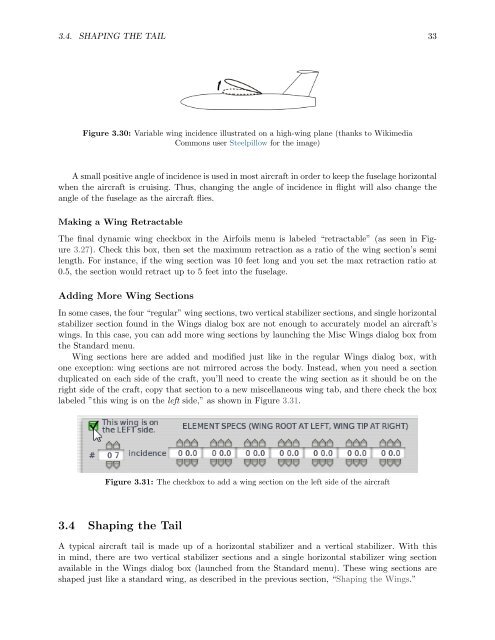Download the Plane Maker Manual - X-Plane
Download the Plane Maker Manual - X-Plane
Download the Plane Maker Manual - X-Plane
You also want an ePaper? Increase the reach of your titles
YUMPU automatically turns print PDFs into web optimized ePapers that Google loves.
3.4. SHAPING THE TAIL 33<br />
Figure 3.30: Variable wing incidence illustrated on a high-wing plane (thanks to Wikimedia<br />
Commons user Steelpillow for <strong>the</strong> image)<br />
A small positive angle of incidence is used in most aircraft in order to keep <strong>the</strong> fuselage horizontal<br />
when <strong>the</strong> aircraft is cruising. Thus, changing <strong>the</strong> angle of incidence in flight will also change <strong>the</strong><br />
angle of <strong>the</strong> fuselage as <strong>the</strong> aircraft flies.<br />
Making a Wing Retractable<br />
The final dynamic wing checkbox in <strong>the</strong> Airfoils menu is labeled “retractable” (as seen in Figure<br />
3.27). Check this box, <strong>the</strong>n set <strong>the</strong> maximum retraction as a ratio of <strong>the</strong> wing section’s semi<br />
length. For instance, if <strong>the</strong> wing section was 10 feet long and you set <strong>the</strong> max retraction ratio at<br />
0.5, <strong>the</strong> section would retract up to 5 feet into <strong>the</strong> fuselage.<br />
Adding More Wing Sections<br />
In some cases, <strong>the</strong> four “regular” wing sections, two vertical stabilizer sections, and single horizontal<br />
stabilizer section found in <strong>the</strong> Wings dialog box are not enough to accurately model an aircraft’s<br />
wings. In this case, you can add more wing sections by launching <strong>the</strong> Misc Wings dialog box from<br />
<strong>the</strong> Standard menu.<br />
Wing sections here are added and modified just like in <strong>the</strong> regular Wings dialog box, with<br />
one exception: wing sections are not mirrored across <strong>the</strong> body. Instead, when you need a section<br />
duplicated on each side of <strong>the</strong> craft, you’ll need to create <strong>the</strong> wing section as it should be on <strong>the</strong><br />
right side of <strong>the</strong> craft, copy that section to a new miscellaneous wing tab, and <strong>the</strong>re check <strong>the</strong> box<br />
labeled ”this wing is on <strong>the</strong> left side,” as shown in Figure 3.31.<br />
Figure 3.31: The checkbox to add a wing section on <strong>the</strong> left side of <strong>the</strong> aircraft<br />
3.4 Shaping <strong>the</strong> Tail<br />
A typical aircraft tail is made up of a horizontal stabilizer and a vertical stabilizer. With this<br />
in mind, <strong>the</strong>re are two vertical stabilizer sections and a single horizontal stabilizer wing section<br />
available in <strong>the</strong> Wings dialog box (launched from <strong>the</strong> Standard menu). These wing sections are<br />
shaped just like a standard wing, as described in <strong>the</strong> previous section, “Shaping <strong>the</strong> Wings.”














